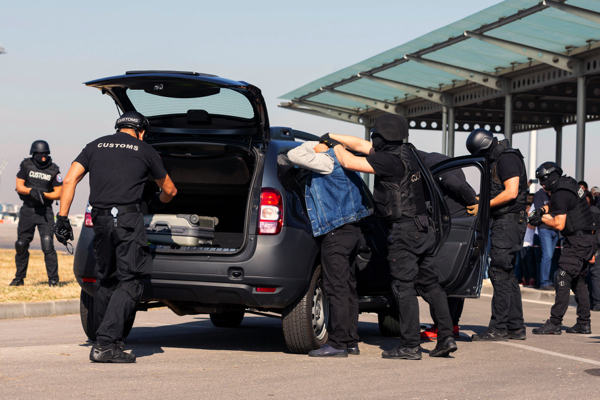
Artificial baits and lures
Flies, jig heads, metal spoons and plugs can help you catch a diverse array of fish species. These items are also stored well in kits. Get small glow-in-the-dark lures and jigs for both ice fishing and night fishing. If possible, avoid plastic baits because they can break down, melt and stick together if you sometimes leave your fishing kit in an area with high temperatures or keep it stored for long a long time. Replace treble hooks with single or double hooks so you can pack lures flatter in smaller kits.Bait
Unless you have a way to dehydrate fresh bait, it won't store well in your survival kit. Instead, buy dehydrated mealworms. Synthetic bait stores better and you can store synthetic crappie bites or salmon eggs in small plastic tubes with PVC end caps or repurposed plastic needle holders.Fishhook recommendations
Long-shank Aberdeen & O’Shaughnessy fishhooks are great for survival fishing because the long shank gives you something to grab when removing hooks from fish. You can also use these hooks to tie flies and make plugs, spoons, jigs and other artificial baits. Simply add a shaped aluminum spoon from a beverage can, carve a wooden plug or body, add scraps of brightly colored cloth or reflective adhesive tape, or tie on some hair or feathers. Additionally, the long shank can help prevent toothed fish from biting through your line. You can also get weedless hooks or short-shanked baitholder hooks if they are effective on species found in the area where you are going to be using your kit. If you have enough space in your kit, get a range of hook sizes since they nest better for packing in a small resealable bag. It's better to get smaller rather than larger sizes, especially since "you can catch a big fish on a small hook, but you can’t catch a small fish on a big hook." The more baited hooks you get in the water, the better your chances of catching fish and the better your chances of survival. Seal indicating desiccant pellets in the bag with your hooks to prevent rusting. If you think you might have to fish in saltwater, get stainless steel hooks or other materials and finishes suitable for use in saltwater. Saltwater fishing hooks are usually made of one of two materials: Stainless steel or high-carbon steel. Stainless steel hooks are corrosion-resistant, but brittle, while high-carbon steel hooks will rust, but are more forgiving of bends and twists. Both materials require care and maintenance to sustain.Fishing line tips
You will need a lighter fishing line in the 8-15 lbs. range for small fish and baitfish. Use a heavier fishing line in the 30-60 lbs. range for gamefish and hand line in the 80-200 lbs. range of hand, trot, bank and drop lines and for float and foot or sinker lines for gill nets, if you want to make one. Attempting to take fish that needs a line stronger than 60 lbs. in a survival scenario could result in either injury or even damaged or lost equipment. The braided line is great as a fishing line for survival fishing kits. Look for 85-188 lbs. Kevlar, 200 lbs. Technora, type 1A paracord, or tarred bank line for the heavier handline. Store your fishing line on a thread card or kite winder. Use a silicone bobbin, handline reel/caster, or a small Cuban yo-yo to help prevent braided line from kinking and to cast and retrieve the fishing line.Floats
When prepping your fishing kit, get plastic Adjust-a-Bubble floats that are more rugged than Styrofoam floats. The former also packs flatter than round bobbers. You can also improvise floats from wood if you have a sharp knife in your kit.Gaff hook
Lash a large 6/0-9/0 long-shank O’Shaughnessy hook to a short handle to make a gaff hook and prevent loss during landing, which is usually when most fish are lost.Gig or fish spearhead
If the fish aren't biting, you can try catching fish with a spear. Use a paralyzer gig head because it's compact and lightweight. Prepare the shaft and use zip ties or cordage to lash it to the shaft to make a gig or fish spear. Add a band of surgical tubing or other elastic material to the base if you want to make a fling spear.Leaders and leader wire
You will need wire leaders if you are fishing for toothy predatory species that may otherwise bite through your line. If you want variety in your kit, add knot-able, coated stainless steel leader wire, strong swivels and snap hooks so you can make the type and length of leader you need. Like braided fishing lines, only certain knots work with knot-able leader wire, so add notes in the instructions you include in your kit.Moisture management
Always store your fishing kit in a water-resistant pouch or box to prevent water from getting in. Adding indicating desiccants will absorb moisture and non-toxic, odorless, tasteless rust preventatives will prevent rust. Indicating desiccants include beads that change colors when they have adsorbed water and can be reused after the water is dried out of them by heating them in an oven. Choose equipment made of rust-resistant materials so your equipment can still be used when needed. Most fishhooks and hardware made from ferrous metals will eventually rust and cheap freshwater hooks used in saltwater will rust faster.Reference materials, like fishing instructions and knot diagrams
Even if you are an experienced fisherman, you can still benefit from having reference materials about the basics of fishing. If SHTF, there's a chance you won't be operating near your full cognitive capacity due to factors like fear, pain, injury, or hunger. This highlights the need to also prepare potentially life-saving information that is difficult to remember. Your fishing kit should include diagrams of trot, bank and drop lines for various species and fishing knots, and info on which knots are best for braided line or knot-able leader wire, or joining different types and sizes of line. Even if you think you already know these things by heart, someone else could end up using your kit to save lives. (Related: Food supply 101: Fish, a cheap and easy survival food.)Speedhook snares
Military Speedhook snares are lighter than fishing yo-yos and are highly effective. They can be set at any depth and can also be used to catch birds and squirrels. Like bank lines, they also fish for you while you take care of other tasks when SHTF. Unlike bank lines, they set the hook.Sturdy storage containers and extending item storage life
Some fishing gear stores better than others and manufacturers recommend replacing monofilament fishing lines after one year or two. After this period, they become brittle and are easier to break. Fluorocarbon lines last a little longer at four to six years, while braided fishing lines should be replaced after eight to 12 years. If you fish frequently, you know that you can still catch fish with old fishing lines. But when SHTF, it's better not to leave things to chance. Make sure you replace the items in your fishing kit regularly. Consider the type of line you choose, and opt for lines that can be stored for years before use so they last longer in your kit. Sharp fishhooks give you a greater chance of landing your catch, but they can become dulled by bumping up against hard equipment in your fishing kit. They can also puncture plastic bags or expensive water-resistant pouches if stored improperly, resulting in water getting into the kit. You can protect the points of fishhooks by stripping a short length of insulation of electrical wire that is a bit smaller in diameter than the hook itself. Push the tip of the hook into the insulation. This takes up very little space in your kit and can help protect your hook from your kit and vice versa.Swivels
Swivels help prevent your fishing line from twisting and getting tangled. Sturdy swivels and snap hooks are small and can be used for casting with a handline. Choose saltwater swivels and snap hooks rated for your leader wire so you don't have to carry more than one size. They can also be used with wire snares to prevent trapped animals from breaking the wire by twisting it. If you have extra space in your kit, include heavier swivels for trapping in your survival or fishing kit.Tools
Include a small pair of sturdy pliers and a knife in your fishing kit. If space is an issue, include a scalpel blade or Derma-Safe razor in your fishing kit.Weights
Removable split shot sinkers and bank sinkers will cover many of your survival fishing needs, but having a couple of egg sinkers may come in handy for casting with a handline. If you are fishing on land, make improvised weight from pebbles and leader wire or a length of brass snare wire. Casting with handlines requires heavier sinkers that many recreational fishermen will often use with their fishing rods. Before SHTF, prepare a comprehensive fishing kit so you can find food for your family when it and other resources become scarce. Watch the video below to learn more about other useful items you should include in your survival and fishing kit. This video is from the Daily Videos channel on Brighteon.com.More related stories:
Prepping tips: 16 Alternative containers for your bug-out gear. Survival essentials: 5 Bushcraft skills for preppers. Prepping 101: How to create and store a survival kit. Sources include: Survivopedia.com TakeMeFishing.org Brighteon.com5 Tips on how to shield your finances from debt default
By Zoey Sky // Share
Homesteading 101: How to start your own medicinal herb garden
By Zoey Sky // Share
Mike Adams and Uncle V discuss why Epic Cash is superior PRIVATE digital money
By Kevin Hughes // Share
Weather forecasters: El Niño is coming this summer and will likely stretch into winter
By Laura Harris // Share
Wild foods you can forage and pickle for long-term storage
By Olivia Cook // Share
North Korea advances nuclear submarine program as Kim Jong Un oversees missile tests
By kevinhughes // Share
USCIS touts historic immigration enforcement under Trump administration
By willowt // Share
Nvidia strengthens AI dominance with strategic Groq talent acquisition and licensing deal
By kevinhughes // Share
Landmark study links even light alcohol use to soaring mouth cancer risk
By avagrace // Share











